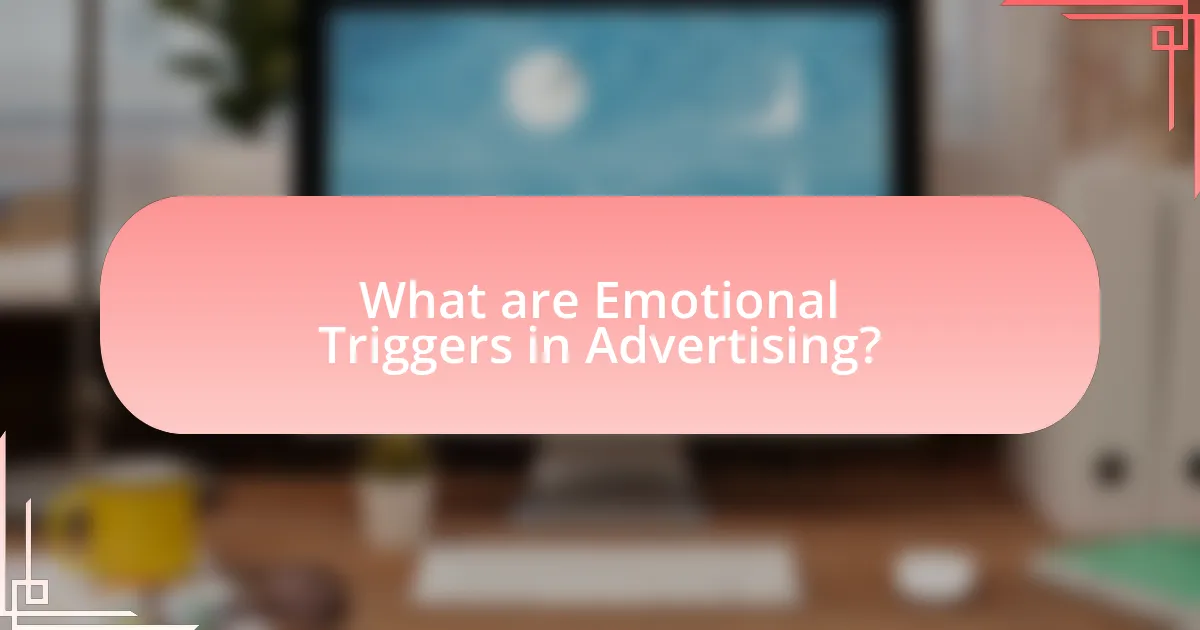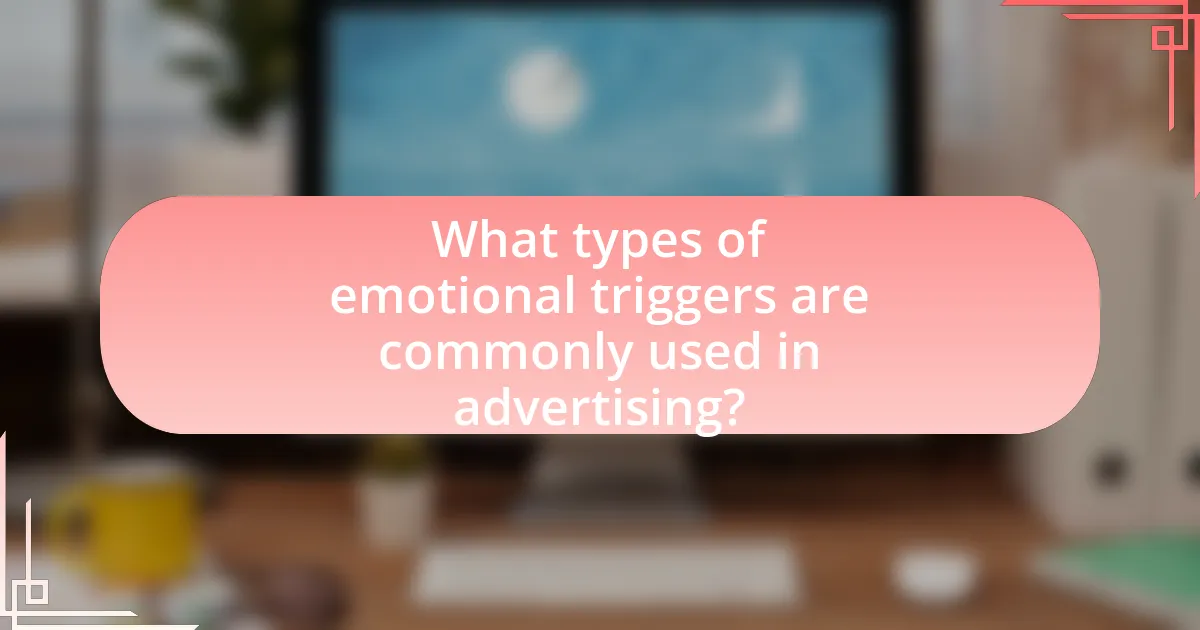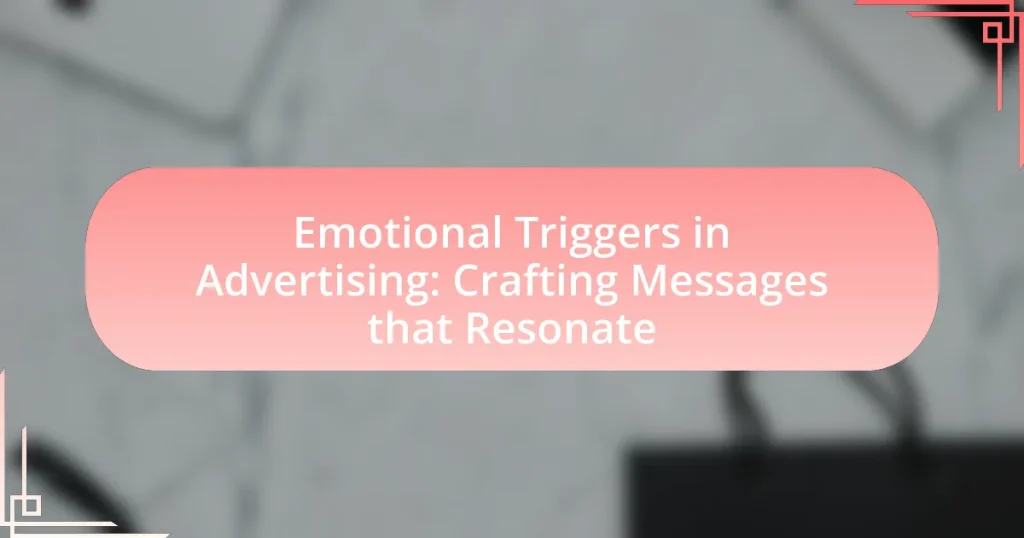Emotional triggers in advertising are psychological stimuli that evoke specific feelings in consumers, significantly influencing their purchasing decisions. This article explores how emotions such as happiness, fear, and nostalgia can enhance consumer engagement, brand loyalty, and message retention. It examines the psychological principles behind emotional triggers, the impact of positive and negative emotions on decision-making, and the ethical considerations involved in their use. Additionally, it provides practical strategies for advertisers to craft emotionally resonant messages, including the importance of storytelling and understanding audience emotions.

What are Emotional Triggers in Advertising?
Emotional triggers in advertising are psychological stimuli that evoke specific feelings in consumers, influencing their purchasing decisions. These triggers can include emotions such as happiness, fear, nostalgia, or anger, which advertisers strategically use to create a connection with their audience. Research indicates that ads that elicit strong emotional responses can increase engagement and brand recall; for instance, a study by the Nielsen Company found that emotionally charged ads are twice as effective as rational ones in driving sales.
How do emotional triggers influence consumer behavior?
Emotional triggers significantly influence consumer behavior by evoking feelings that drive purchasing decisions. When consumers experience emotions such as happiness, fear, or nostalgia, they are more likely to engage with a brand and make a purchase. For instance, a study published in the Journal of Consumer Research found that advertisements eliciting positive emotions can increase brand recall and purchase intent by up to 50%. This demonstrates that emotional resonance in advertising not only captures attention but also fosters a deeper connection with consumers, ultimately impacting their buying choices.
What psychological principles underpin emotional triggers?
Psychological principles that underpin emotional triggers include the concepts of classical conditioning, emotional contagion, and the mere exposure effect. Classical conditioning explains how repeated associations between stimuli can evoke emotional responses; for instance, pairing a product with positive imagery can create favorable feelings towards that product. Emotional contagion refers to the phenomenon where individuals mimic the emotions of others, which can be leveraged in advertising to create relatable and impactful messages. The mere exposure effect suggests that people tend to develop a preference for things merely because they are familiar with them, indicating that repeated exposure to emotionally charged advertisements can enhance consumer affinity. These principles are supported by research, such as the work of Pavlov on classical conditioning and studies on emotional contagion by Hatfield et al., which demonstrate the effectiveness of these psychological mechanisms in influencing consumer behavior.
How do emotions affect decision-making in advertising?
Emotions significantly influence decision-making in advertising by shaping consumer perceptions and behaviors. Advertisements that evoke strong emotional responses, such as happiness, fear, or nostalgia, can enhance brand recall and increase the likelihood of purchase. Research indicates that emotionally charged ads are more memorable; for instance, a study published in the Journal of Advertising Research found that emotional ads lead to a 23% increase in sales compared to non-emotional ads. This demonstrates that emotions not only drive engagement but also directly impact consumer choices, making emotional appeal a critical strategy in effective advertising.
Why are emotional triggers important in crafting messages?
Emotional triggers are important in crafting messages because they significantly enhance audience engagement and influence decision-making. Research indicates that emotionally charged messages can increase recall and persuasion, with studies showing that emotional content is processed more deeply than neutral content. For instance, a study published in the Journal of Consumer Research found that advertisements evoking emotions like happiness or fear led to higher purchase intentions compared to those that did not. This demonstrates that leveraging emotional triggers effectively can create a stronger connection with the audience, ultimately driving desired actions.
What role do emotional triggers play in brand loyalty?
Emotional triggers significantly enhance brand loyalty by creating strong, positive associations between consumers and brands. When brands evoke emotions such as happiness, nostalgia, or trust, they foster a deeper connection that encourages repeat purchases and long-term commitment. Research indicates that emotionally connected customers are more than twice as valuable as highly satisfied customers, as they exhibit higher levels of loyalty and advocacy. For instance, a study by the Harvard Business Review found that emotionally engaged customers are more likely to recommend a brand and remain loyal, demonstrating the critical role of emotional triggers in cultivating brand loyalty.
How can emotional triggers enhance message retention?
Emotional triggers enhance message retention by creating a stronger connection between the audience and the content. When individuals experience emotions such as joy, fear, or sadness, their brains release neurotransmitters like dopamine and cortisol, which facilitate memory formation. Research indicates that emotionally charged messages are more likely to be remembered; for instance, a study published in the Journal of Consumer Research found that emotional appeals can increase recall by up to 50% compared to neutral messages. This heightened retention occurs because emotions engage the amygdala, a brain region critical for processing emotional experiences, thereby reinforcing the memory of the message.

What types of emotional triggers are commonly used in advertising?
Common emotional triggers used in advertising include fear, happiness, sadness, surprise, and trust. Fear is often leveraged to create urgency or highlight potential loss, prompting consumers to act quickly. Happiness is utilized to evoke positive feelings associated with a product, enhancing brand affinity. Sadness can be employed to foster empathy and connection, making the message more relatable. Surprise captures attention and can lead to increased memorability of the advertisement. Trust is built through testimonials and brand reputation, encouraging consumer confidence in purchasing decisions. These emotional triggers are effective because they resonate with consumers on a personal level, influencing their behavior and decision-making processes.
How do positive emotions drive consumer engagement?
Positive emotions drive consumer engagement by enhancing brand affinity and increasing the likelihood of purchase. When consumers experience positive emotions, such as joy or excitement, they are more likely to connect with a brand on an emotional level, leading to higher engagement rates. Research indicates that emotionally charged advertisements can increase consumer recall and brand loyalty; for instance, a study published in the Journal of Advertising Research found that ads eliciting positive emotions resulted in a 23% increase in purchase intent compared to neutral ads. This demonstrates that positive emotions not only capture attention but also foster a deeper relationship between consumers and brands, ultimately driving engagement.
What are examples of positive emotional triggers in successful campaigns?
Examples of positive emotional triggers in successful campaigns include nostalgia, happiness, and inspiration. Nostalgia is effectively utilized in campaigns like Coca-Cola’s “Share a Coke,” which evokes fond memories associated with personal names on bottles. Happiness is often triggered through humor, as seen in Old Spice’s “The Man Your Man Could Smell Like,” which combines wit and charm to create a joyful experience. Inspiration is harnessed in campaigns like Nike’s “Just Do It,” which motivates individuals to pursue their goals, fostering a sense of empowerment. These emotional triggers enhance consumer engagement and brand loyalty, demonstrating their effectiveness in advertising.
How can brands evoke happiness and joy through advertising?
Brands can evoke happiness and joy through advertising by utilizing positive imagery, relatable storytelling, and humor. Positive imagery, such as vibrant colors and smiling faces, creates an immediate association with joy, while relatable storytelling allows consumers to connect emotionally with the brand’s message, fostering a sense of belonging and happiness. Humor, when effectively integrated, can enhance memorability and create a positive emotional response, leading to increased brand affinity. Research indicates that advertisements featuring humor can increase purchase intent by up to 50%, demonstrating the effectiveness of these strategies in eliciting joy and happiness in consumers.
What negative emotions can be leveraged in advertising?
Negative emotions that can be leveraged in advertising include fear, guilt, shame, and sadness. Fear can motivate consumers to take action to avoid negative outcomes, as seen in anti-smoking campaigns that highlight health risks. Guilt can be used to encourage pro-social behavior, such as in campaigns that promote charitable donations by making individuals feel responsible for societal issues. Shame can drive consumers to change behaviors or purchase products that enhance their self-image, often utilized in beauty and personal care advertising. Lastly, sadness can evoke empathy and connection, effectively used in advertisements that tell poignant stories to foster brand loyalty. These emotions are effective because they tap into fundamental human experiences, prompting immediate responses and influencing consumer behavior.
How do fear and anxiety influence consumer responses?
Fear and anxiety significantly influence consumer responses by triggering heightened emotional reactions that can lead to impulsive decision-making. When consumers experience fear, they often seek to alleviate that fear through immediate purchases, particularly in situations where they perceive a threat or risk, such as health concerns or financial instability. Research indicates that fear-based advertising can increase the urgency to act; for example, a study published in the Journal of Advertising Research found that fear appeals can enhance message effectiveness by creating a sense of urgency, prompting consumers to take action to mitigate perceived risks. Additionally, anxiety can lead to avoidance behaviors, where consumers may withdraw from making decisions altogether or seek reassurance through social proof or expert endorsements. This dual influence of fear and anxiety shapes how consumers engage with brands and products, ultimately affecting their purchasing behavior.
What are the ethical considerations when using negative emotional triggers?
Using negative emotional triggers in advertising raises significant ethical considerations, primarily concerning the potential for manipulation and harm to consumers. Advertisers must ensure that their messaging does not exploit vulnerabilities, as research indicates that negative emotions can lead to adverse psychological effects, such as anxiety or depression. For instance, a study published in the Journal of Advertising Research highlights that while negative emotional appeals can increase attention, they may also result in backlash if perceived as overly manipulative or insincere. Furthermore, ethical advertising practices necessitate transparency and respect for consumer autonomy, ensuring that individuals are not coerced into making decisions based on fear or distress.

How can advertisers effectively craft messages that resonate emotionally?
Advertisers can effectively craft messages that resonate emotionally by utilizing storytelling, understanding their audience’s values, and incorporating relatable experiences. Storytelling engages consumers by creating a narrative that evokes emotions, making the message memorable. Research indicates that emotional storytelling can increase brand recall by up to 22 times compared to non-emotional content. Additionally, advertisers should conduct audience analysis to identify core values and pain points, allowing them to tailor messages that align with consumers’ beliefs and aspirations. For instance, a study by the Nielsen Company found that ads with emotional appeal outperform those with purely rational messages, leading to a 23% increase in sales. By combining these strategies, advertisers can create impactful messages that foster emotional connections with their audience.
What strategies can be employed to identify target audience emotions?
To identify target audience emotions, marketers can employ strategies such as conducting surveys, analyzing social media sentiment, and utilizing focus groups. Surveys allow for direct feedback from the audience regarding their feelings and preferences, providing quantitative data on emotional responses. Analyzing social media sentiment involves using tools to gauge public opinion and emotional tone in user-generated content, which can reveal underlying emotions associated with a brand or product. Focus groups facilitate in-depth discussions, enabling marketers to observe emotional reactions and gather qualitative insights. These strategies are validated by research indicating that understanding audience emotions significantly enhances the effectiveness of advertising campaigns, as emotional engagement is linked to increased brand loyalty and consumer behavior.
How can market research inform emotional messaging strategies?
Market research can inform emotional messaging strategies by identifying consumer emotions and preferences that drive purchasing decisions. Through surveys, focus groups, and data analysis, businesses can uncover insights into what emotions resonate with their target audience, such as happiness, nostalgia, or fear. For instance, a study by Nielsen found that ads that evoke strong emotional responses can lead to a 23% increase in sales compared to those that do not. By leveraging these insights, brands can tailor their messaging to align with the emotional triggers of their audience, enhancing engagement and effectiveness in advertising campaigns.
What tools can be used to measure emotional responses to advertisements?
Tools that can be used to measure emotional responses to advertisements include facial coding, biometric sensors, and self-report surveys. Facial coding analyzes facial expressions to identify emotions, providing real-time data on viewer reactions. Biometric sensors, such as heart rate monitors and galvanic skin response devices, measure physiological responses that correlate with emotional states. Self-report surveys gather subjective feedback from viewers about their emotional experiences after exposure to advertisements. Research has shown that these methods can effectively capture the nuances of emotional engagement, enhancing the understanding of consumer reactions to advertising content.
What best practices should be followed when using emotional triggers?
To effectively use emotional triggers in advertising, marketers should ensure that the emotional appeal aligns with the brand’s message and values. This alignment fosters authenticity, which is crucial for building trust with the audience. Research indicates that emotionally charged advertisements can increase engagement by up to 23 times compared to non-emotional content, as shown in a study by the Nielsen Company. Additionally, marketers should focus on storytelling, as narratives that evoke emotions can create a deeper connection with consumers, leading to higher retention rates. Using relatable characters and situations enhances this connection, making the emotional trigger more impactful. Lastly, it is essential to test and analyze the emotional responses of the target audience to refine strategies, ensuring that the emotional triggers resonate effectively.
How can storytelling enhance emotional resonance in advertising?
Storytelling enhances emotional resonance in advertising by creating relatable narratives that evoke empathy and connection. When brands use storytelling, they engage consumers on a deeper emotional level, making the message more memorable and impactful. Research indicates that narratives can activate brain regions associated with emotions, leading to increased engagement; for instance, a study published in the Journal of Consumer Research found that stories can enhance the likelihood of purchase decisions by up to 30%. This emotional engagement fosters brand loyalty and encourages consumers to share their experiences, amplifying the advertising’s reach and effectiveness.
What are common pitfalls to avoid when crafting emotionally-driven messages?
Common pitfalls to avoid when crafting emotionally-driven messages include using vague language, failing to understand the target audience, and overloading the message with emotions. Vague language can dilute the emotional impact, making it difficult for the audience to connect with the message. Understanding the target audience is crucial; messages that do not resonate with their values or experiences will likely be ineffective. Overloading the message with excessive emotions can overwhelm the audience, leading to confusion rather than engagement. These pitfalls can hinder the effectiveness of emotionally-driven advertising, as evidenced by studies showing that clear, targeted messaging significantly increases audience engagement and response rates.
What practical tips can advertisers implement to create emotionally resonant messages?
Advertisers can create emotionally resonant messages by utilizing storytelling, evoking empathy, and leveraging relatable experiences. Storytelling engages audiences by presenting a narrative that connects with their emotions, making the message more memorable. For instance, brands like Nike often share personal stories of athletes overcoming challenges, which resonate deeply with viewers.
Evoking empathy involves understanding the audience’s feelings and perspectives, allowing advertisers to craft messages that reflect their struggles or aspirations. Research shows that ads that trigger empathy can increase consumer engagement by up to 50%.
Leveraging relatable experiences ensures that the message aligns with the audience’s daily lives, making it more impactful. For example, advertisements that depict common family scenarios or workplace challenges can foster a sense of connection. By implementing these strategies, advertisers can effectively create messages that resonate on an emotional level.


